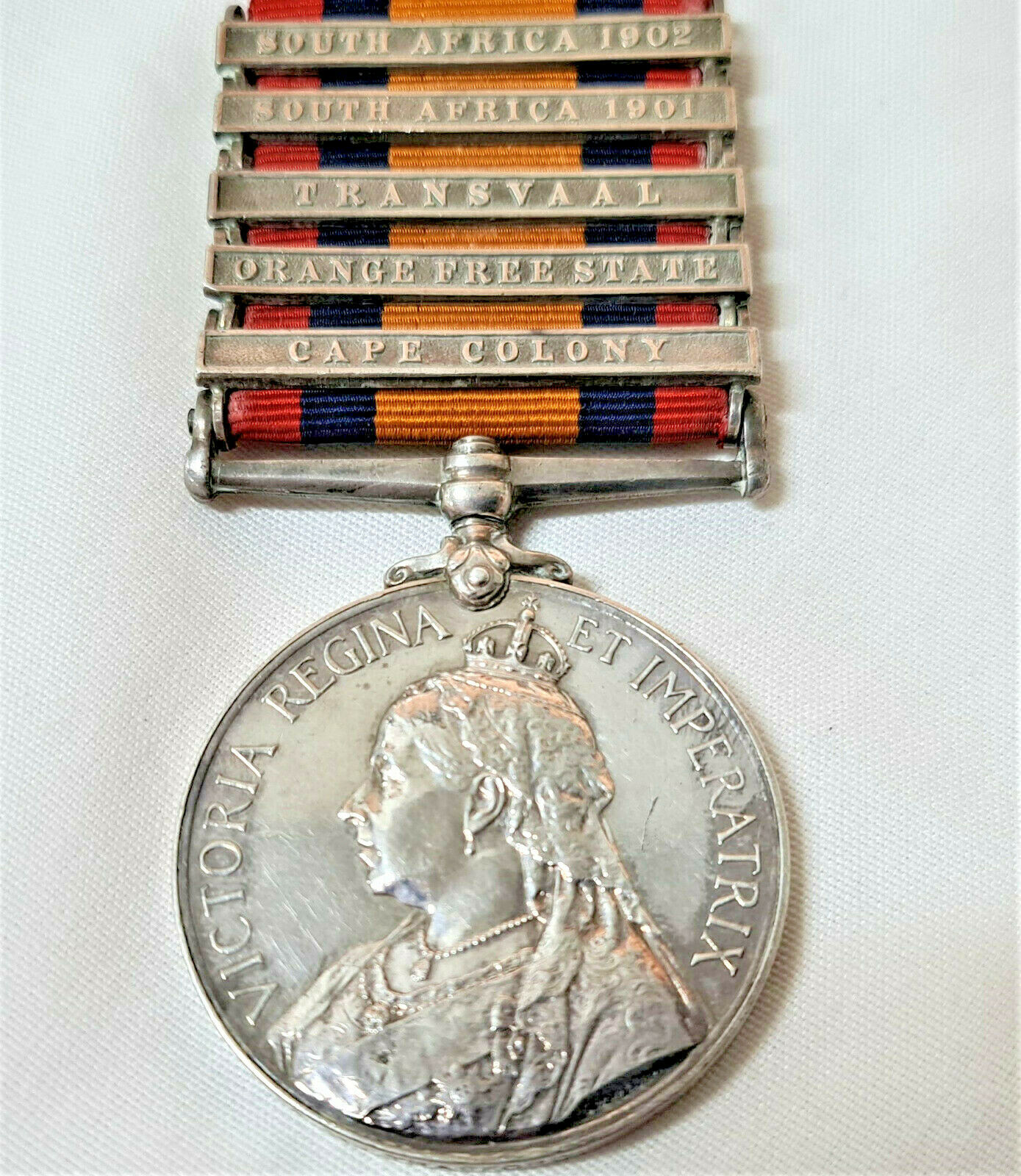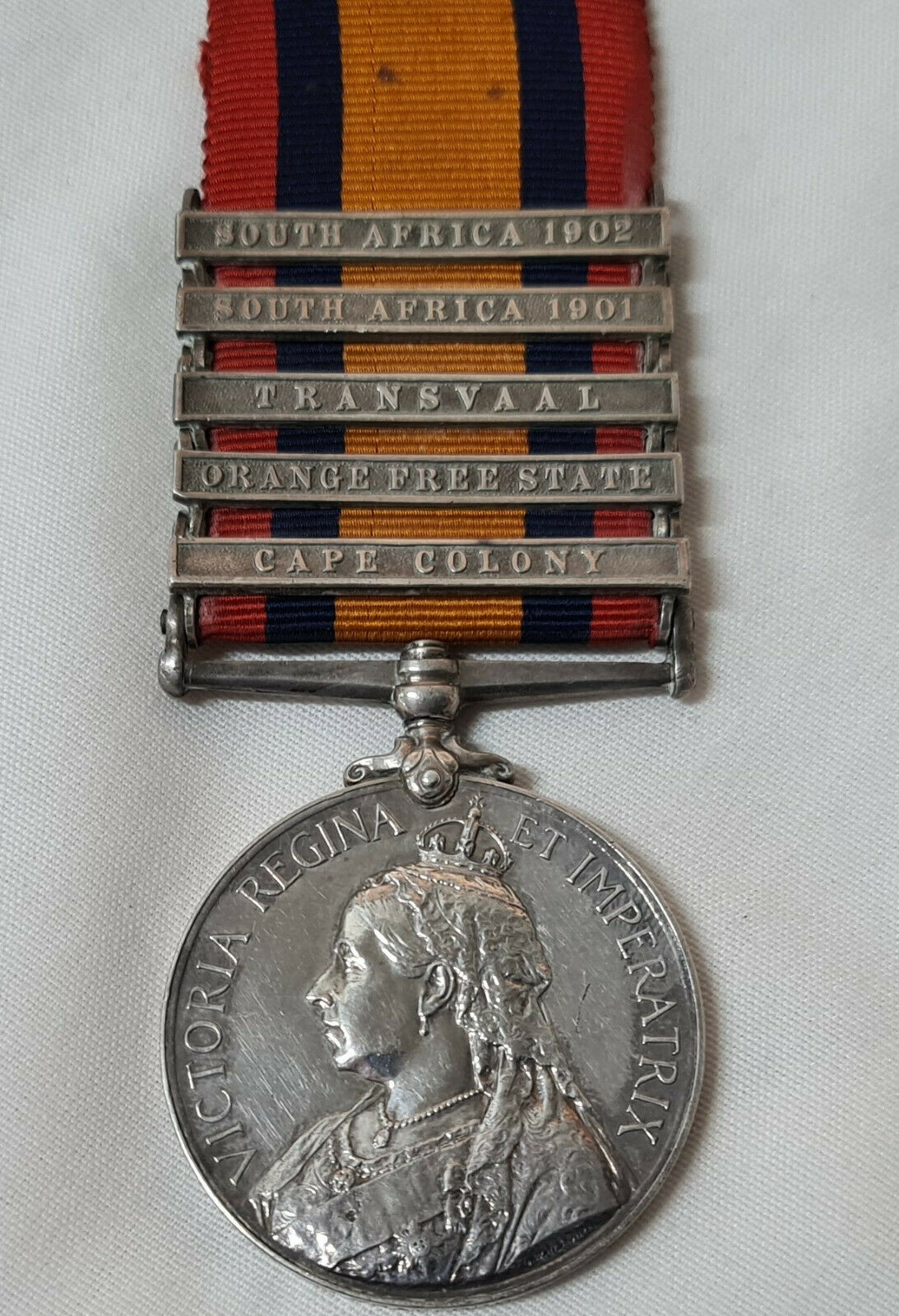SOLD
BRITISH QUEENS SOUTH AFRICA MEDAL: 32051 WILLIAM TRAFFORD 29TH DENBIGHSHIRE COY 9TH BN IMP YEO
Offered is a nice 5 clasp Queen’s South Africa Medal to Private Trafford, who was part of the notorious 2nd Contingent Imperial Yeomanry, that were sent to the war with nil training/experience to be taught ‘ in theatre. Queens South Africa Medal 1899 – 1902 with 5 clasps, CAPE COLONY, ORANGE FREE STATE, TRANSVAAL, SOUTH AFRICA 1901, SOUTH AFRICA 1902. Impressed named 32051 PTE W. TRAFFORD. 29TH COY IMP: YEO. Comes with copies service papers, medal rolls & basic research. William Trafford was born in Eig Clyryres, Langollen, Denbighshire in 1866, he enlisted at Wrexham to the 29th Company (Denbighshire) 9th Battalion, Imperial Yeomanry on the 1st March 1901 for a 1 year period of active service in South Africa. He was nearly 36 at the time and working as a labourer. On his enlistment papers it is recorded that he had nil previous service, he served England 1/3/1901 – 29/3/190 (28 days!) before being deployed to South Africa 30/3/1901 – 27/8/1902, England 28/8/1902 to discharge on 3/9/1902. By the end of March 1901, almost 30% of the original 10,000+ Imperial Yeomanry had been killed, injured or taken prisoner, though the majority of losses were caused by disease. A number […]
$195.00
SOLD
Offered is a nice 5 clasp Queen's South Africa Medal to Private Trafford, who was part of the notorious 2nd Contingent Imperial Yeomanry, that were sent to the war with nil training/experience to be taught ‘ in theatre.
Queens South Africa Medal 1899 – 1902 with 5 clasps, CAPE COLONY, ORANGE FREE STATE, TRANSVAAL, SOUTH AFRICA 1901, SOUTH AFRICA 1902. Impressed named 32051 PTE W. TRAFFORD. 29TH COY IMP: YEO. Comes with copies service papers, medal rolls & basic research.
William Trafford was born in Eig Clyryres, Langollen, Denbighshire in 1866, he enlisted at Wrexham to the 29th Company (Denbighshire) 9th Battalion, Imperial Yeomanry on the 1st March 1901 for a 1 year period of active service in South Africa. He was nearly 36 at the time and working as a labourer.
On his enlistment papers it is recorded that he had nil previous service, he served England 1/3/1901 – 29/3/190 (28 days!) before being deployed to South Africa 30/3/1901 – 27/8/1902, England 28/8/1902 to discharge on 3/9/1902.
By the end of March 1901, almost 30% of the original 10,000+ Imperial Yeomanry had been killed, injured or taken prisoner, though the majority of losses were caused by disease.
A number of issues conspired against the second contingent. Recruitment, which had ceased after the first contingent had been raised, had to be restarted. The original intention was, as with the first contingent, to train new recruits for two or three months before sending them to South Africa, but the new Commander-in-Chief, Lord Kitchener, decided that they should be trained in-theatre and ordered that they be sent immediately. He failed to appreciate, however, that a pay rise had attracted a significantly greater number of working class recruits who had no prior experience of horses or firearms. Lord Chesham, who in 1901 became the Inspector General of the Imperial Yeomanry, would later state of the second draft that "the shooting and riding test if it was really applied in all cases, must have been one of very perfunctory character". The difficulties of this sudden injection of raw, untrained recruits were compounded by the fact that only 655 of the original contingent elected to stay on, representing a significant loss of experience. Furthermore, the second tranche of domestic yeomanry officers who provided much of the leadership were not vetted by domestic yeomanry commanders as those few of the first contingent were, and proved to be of poor quality in the field.
General Edmund Allenby regarded the Imperial Yeomanry as useless. By the time they had learned enough to be of use, according to him, they had "probably been captured two or three times, presenting the Boers on each occasion with a horse, rifle and 150 rounds of ammunition per man". The colonial forces in South Africa had labeled the second contingent "De Wet's Own", after the Boer general Christiaan de Wet, so invaluable was it as a source of rifles and horses to the Boers. Questions were asked about the second contingent in the House of Commons, it began to be derided in the press, and in July 1901 Kitchener considered sending it back.
A month later, Kitchener had relented a little, saying that although there were still some who could not be trusted, a good many of the sub-standard yeomanry had been removed and he was getting more value from the best of those remaining.
Additional information
| Weight | 0.2 kg |
|---|---|
| Dimensions | 24 × 2 × 30 cm |





